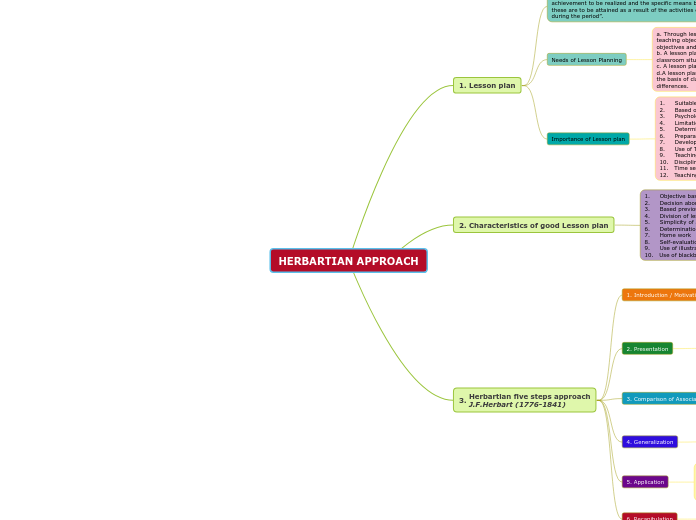HERBARTIAN APPROACH
Lesson plan
“Lesson plan is the title given to a statement of the achievement to be realized and the specific means by which these are to be attained as a result of the activities engaged in during the period”.
Needs of Lesson Planning
a. Through lesson plan, the teacher regularly achieves the teaching objectives and process in the form of complex objectives and processes.
b. A lesson plan develops the possibilities of adjustment in the classroom situation which makes the teaching effective.
c. A lesson plan helps in calling every step of curriculum unit.
d.A lesson plan helps in planning the process of teaching on the basis of class control, motivation and individual differences.
Importance of Lesson plan
1. Suitable Environment
2. Based on previous knowledge
3. Psychological teaching
4. Limitation of subject matter
5. Determination of activities
6. Preparation of material aids
7. Developing of teaching skill
8. Use of Theoretical knowledge
9. Teaching with confidence
10. Discipline in class
11. Time sense
12. Teaching from memory level to reflective level
Characteristics of good Lesson plan
1. Objective based
2. Decision about appropriate material aids
3. Based previous knowledge
4. Division of lesson plan in units
5. Simplicity of activities
6. Determination of activities
7. Home work
8. Self-evaluation
9. Use of illustration
10. Use of blackboard
Herbartian five steps approach
J.F.Herbart (1776-1841)
1. Introduction / Motivation
* This step is concerned with the task of preparing the students for receiving new knowledge.
* The assumption about the previous knowledge of the students in relevance to the lesson
* The testing of the previous knowledge
* Utilizing the previous knowledge for introducing the lesson
* Motivating the students for studying the present lesson
2. Presentation
* The aims of the lesson should be stated clearly and the heading should be written on the blackboard.
* We have to provide situation for both the teacher and the students to participate in the process of teaching and learning. * Our ultimate aim of the presentation is to make the concepts understandable to the students.
3. Comparison of Association
* To compare the facts observed by the students with another concept by way of giving examples. By making use of this comparison, the students can derive definitions or theories.
* The students are encouraged to give new suitable examples for the concept instead of the examples given in the book to make them think in an innovative manner.
4. Generalization
* This step is concerned with arriving at some general ideas or drawing out the necessary conclusions by the students on the basis of the different comparisons, contracts and associated observed in the learning material present by the teacher.
5. Application
* The teacher makes the students to use the understood knowledge in an unfamiliar situation.
* Unless the knowledge of science is applied in new situations or in our day-to-day life, the study of science will become meaningless.
6. Recapitulation
* This stage is meant for the teachers to know whether students have grasped by reviewing a lesson or by giving assignments to the students.
